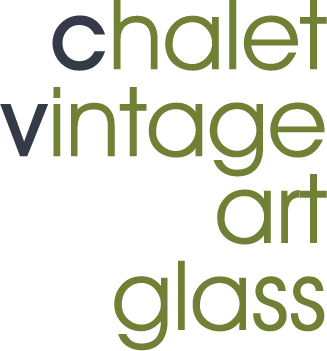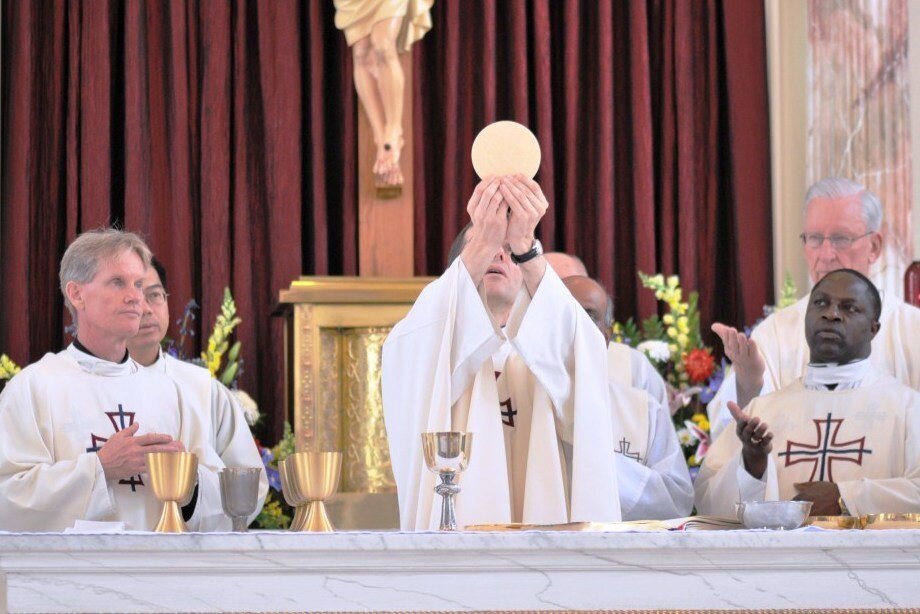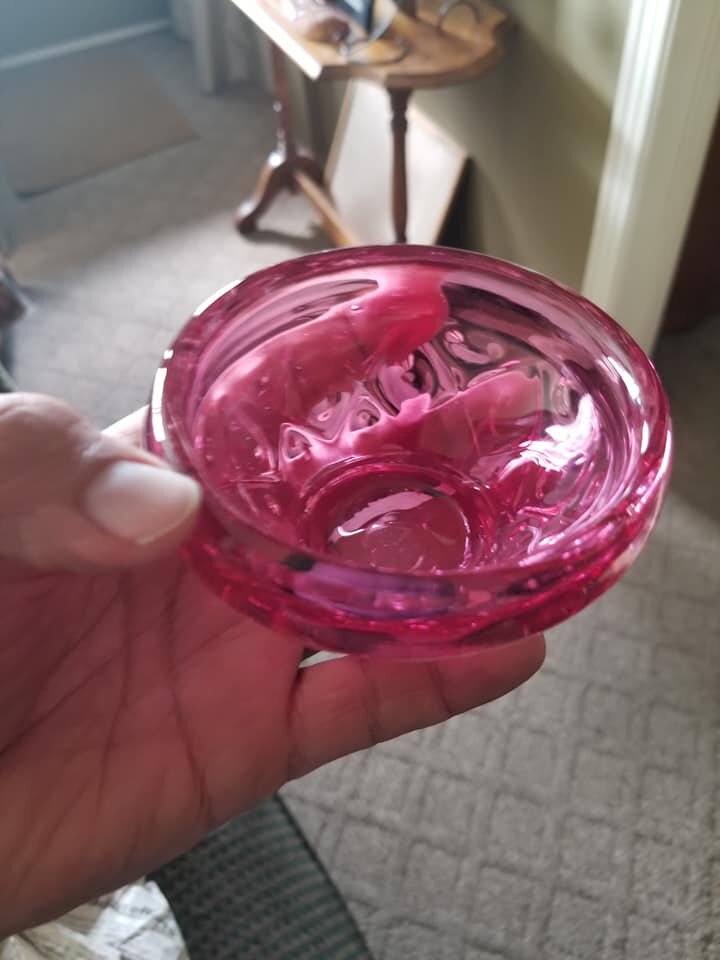The Chalet Eucharist sets
The functionality and purpose of some of the small Chalet pitchers, bowls and the bells need to be viewed with an eye to ‘time and place.’ Why? Many of these were done for church services – specifically for the ‘Eucharist” mass. What is the “Eucharist” ? It is the Christian ceremony commemorating the Last Supper, in which bread and wine are consecrated and consumed. Today, "the Eucharist" is the name still used by Eastern Orthodox, Oriental Orthodox, Catholics, Anglicans, Presbyterians, and Lutherans. Other Protestant denominations rarely use this term, preferring either "Communion", "the Lord's Supper", "Remembrance", or "the Breaking of Bread".
The Eucharist set was made up of 6 or 7 pieces – 4 separate forms. They were done in variations of elaborateness depending on the budget each church parish wished to allot. The sets included a handled “Altar or Eucharist” bell made in either cranberry or clear crystal. A handled pitcher for the wine, a handless vase-like vessel for the water and a small bowl for the wafers. The bowl was sized to cup the base of the pitchers. It was typical that most sets contained more than 1 bowl so that wafers could be distributed more smoothly.
Photograph courtesy of Paolo De Marchi.
This set done in the Chalet “End of Day is missing the handled “Altar or Eucharist” bell made in either cranberry or clear crystal. It does have the handled pitcher for the wine, the handless vase-like vessel for the water and the small bowl for the wafers.
As you see in this unboxing video, I found some rare Chalet bells. Although, I had known about them and was able to include pictures in the new ‘Chalet Artistic Glass Collectors’ Guide and Catalogue’ on page 53, I had never “met” any. And bang – 2 in one day.
As soon as I had secured them, I sent pictures to Paolo De Marchi and asked if he and his father, Chalet artist Roberto De Marchi, could provide us with more information. And as usual – they could and did! This is when I learned that the bells were made for churches as part of the Eucharist set. The ‘Altar bell’ or ‘Sanctus bell’ is typically a small hand-held bell or set of bells used primarily during the Eucharistic celebrations of the Roman Catholic Church. It was fascinating to be able to put these pieces into context as this was a context that simply would never have occurred to me and probably not to most.
Chalet artist Roberto De Marchi remembers that 1 artist and a Master worked to make the bells.
Very nicely done applied handles.
The clangers were attached to a blob of glass with a hanger hole in it. The clangers were typically clear crystal weights This was torched on after the glass was annealed.
So, I quizzed Paolo further - he told me that he had actually been an altar server during his youth and rung the bell. The bells were used to create “….a joyful noise to the Lord” and proclaim the mystery of the Eucharist. Typically, a bell is rung regularly at three places during the service. First, at the time of the epiclesis in the Eucharistic Prayer just before the Consecration. At this time, a bell is rung 3 times to alert the congregation to the calling down of the Holy Spirit and to prepare them for the Consecration that immediately follows. A useful cue for many as the mass was done in Latin. At this point, the priest joins his hands and places them over the bread and wine to be consecrated. He prays for the Holy Spirit to come down upon the gifts so that they may become ‘the Body and Blood of the Lord.‘ At this time, called the ‘Hanc Igitur’, the bell is rung once.
Third, the server rings the bell at the showing of both the Eucharistic Bread and the Chalice.” After the priest says the words of consecration, he elevates the Sacred Host and the Chalice of Precious Blood. The ringing of the bell informs the faithful that “… transubstantiation has taken place and that the Body and Blood of the Lord is truly present on the altar.”
The bell is rung three times at each ‘Elevation’ to “… draw the faithful’s attention to the elevations of the consecrated Host and Precious Blood, and thus look upon and adore their Eucharistic Lord.”
Altar servers kneel with the congregation during the Eucharist prayers. The bell is rung from this position.
I was initially surprised at how large the bells were in comparison to those collected by Ella Hanks. She has a Viking bell that is 6” high and 3 ½” in diameter, a Pilgrim bell that is 7 3/4” high and 4” in diameter and a Moon and Stars bell that is 6” high and 3 ” in diameter while the Chalet clear crystal bell is 9” high and 6” in diameter and the cranberry-coloured bell is 9 1/2” high and 6 ½” in diameter. However, once I learned their purpose, their size made sense. These were functional – not decorative.
Another Chalet bell. Different handle styling but also bearing the Chalet Riekes sticker. I do not have its dimensions but assume from this photo that they would be similar to the ones above as it also looks quite large.
Yet another style. No dimensions available. Also stickered with the Chalet Riekes label.
Handled pitcher for wine. Photograph courtesy of Paolo De Marchi.
Handless pitcher for water. Photograph courtesy of Paolo De Marchi.
Wafer bowl. Photograph courtesy of Paolo De Marchi.
The wafer bowls and pitchers were designed to nestle. Photographs courtesy of Paolo De Marchi.
Please note that Rossi also did Eucharist sets as well after Chalet’s closure.
A stamped “R” and personally signed Angelo Rossi wafer bowl. Photograph courtesy of Marta Michalowski.

















